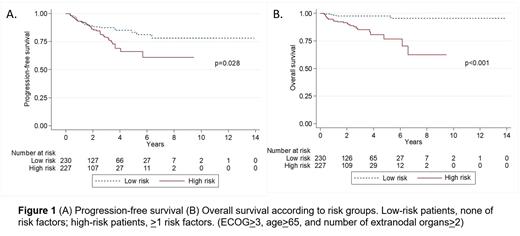Abstract
Introduction: Marginal zone lymphoma (MZL) is the second most common lymphoma subtype in Thailand. Extranodal MZL or mucosal associated lymphoid tissue (MALT) lymphoma is the highest prevalent entity. Although gastric MALT lymphoma is the most common organ of this entity but for Thai population, ocular adnexa MALT lymphoma is the most common primary organ of MALT lymphoma.
Objective: This study aimed to describe epidemiology of MALT lymphoma in Thai population and develop prognostic model for MALT lymphoma.
Patients and methods: Patients (pts) diagnosed with MALT lymphoma were enrolled to the TLSG registry. Demographic data, treatment modalities, survival data were gathered. Univariate and multivariate analyses were done by Cox regression. To test the prognostic indices, Kruskal-Wallis test was performed. Kaplan Meier curves were plotted and log rank test was used to test the difference between risk groups. STATA® version 17 was performed for statistical analyses.
Results: From January 2007 to March 2022, the TLSG has prospectively enrolled 8,404 lymphoma patients to the registry from 15 nationwide medical institutes; of these 670 patients (7.97%) were histologically diagnosed with MZL. Among MZL, MALT lymphoma was the most common entity with 501 pts (77.8%) followed by nodal MZL (117; 17.5%), and splenic MZL (52; 7.7%). Of these MALT lymphoma population, 457 pts with completed follow-up data were eligible for long-term survivals analyses. The three most common primary organs were ocular adnexa (225; 49.2%), gastric (59; 12.9%), and sinonasal (57; 12.5%). Median age at diagnosis was 59 (range;20-95). 162 pts (35.4%) of these were 65 years or older. For gender, male was slightly predominant (56.9%). High ECOG performance status (3-4) in 15 (3.5%). Extensive extranodal organs (>2) in 78 (17%). Advanced stage (III-IV) in 162 (35.4%). High lactate dehydrogenase (LDH) in 112 (24.5%). Presence of B-symptoms in 103 (22.5%). Regarding treatment, chemotherapy (CMT) only was administered in 27.5%, CMT + rituximab (R) 13.4%, CMT + radiation (RT) 11.6%, R+CMT+RT 2.2%, R monotherapy 0.4%, antibiotic eradication 6.6%. Locoregional therapy with RT 24.2% and surgical removal alone in 3.6%. Univariate analysis was performed and found that ECOG>3, age>65, number of extranodal organs>2, B-symptom, stage III-IV, and LDH were potential factors to be used for multivariate analysis. For multivariate analysis, ECOG>3, age>65, and number of extranodal organs >2 were found to be statistically significant affected survivals. These prognostic factors were used and tested for overall and progression-free survivals (OS and PFS, respectively). Patients without any risk factor were classified to be low-risk pts and pts with any of these risk factors were categorized to be high-risk pts. Five-year PFS and OS were significantly better in low-risk pts; vs 83.3% vs 66.1% (p=0.028) and 97.8% vs 76.7% (p<0.001) respectively. (Figures 1A, B)
Conclusion: MZL is the second most prevalent lymphoma subtype in Thailand and MALT lymphoma is the most common entity. The prognostic index for MALT lymphoma showed that patients without any risk factor (ECOG>3, age>65, and number of extranodal organs >2) had statistically significant better PFS and OS.
Disclosures
No relevant conflicts of interest to declare.
Author notes
Asterisk with author names denotes non-ASH members.


This feature is available to Subscribers Only
Sign In or Create an Account Close Modal